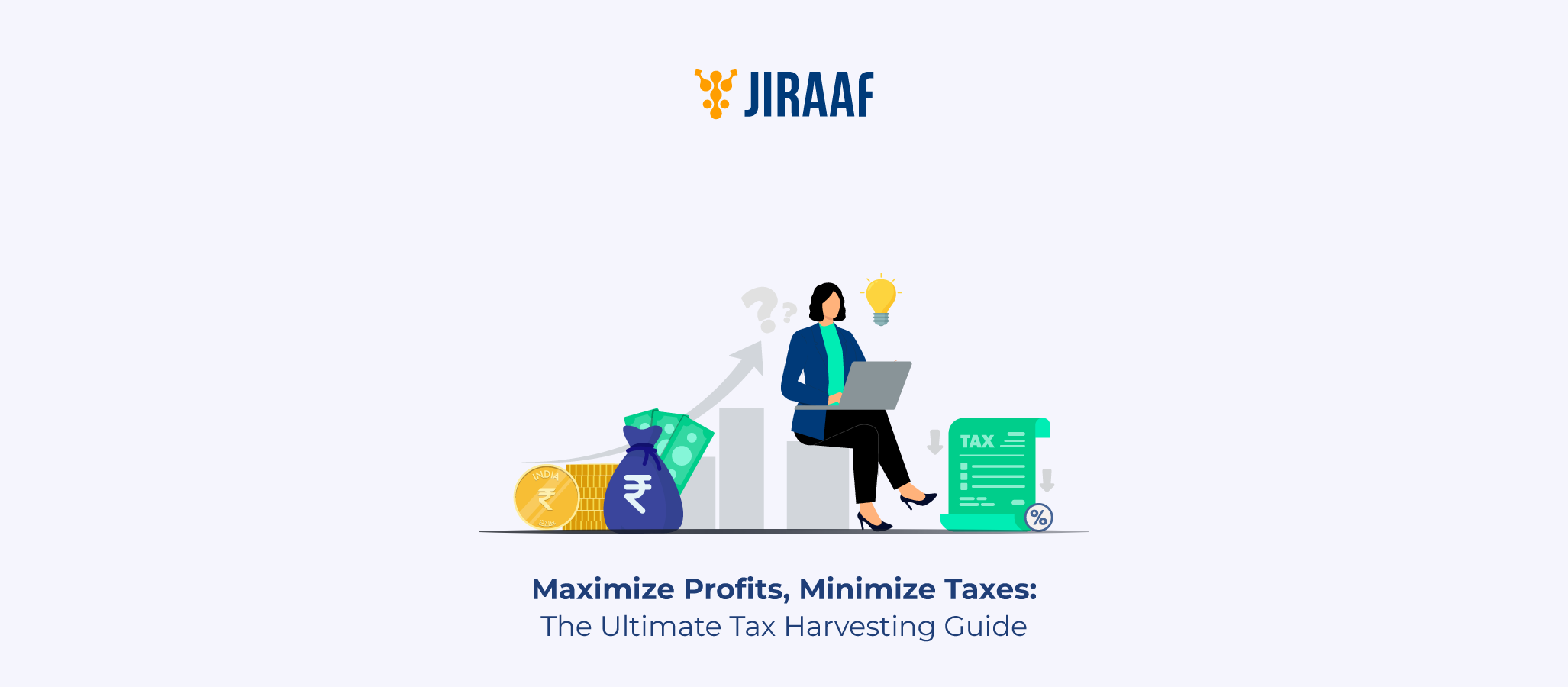You’ve probably heard the phrase “Don’t let taxes eat your returns”, but it’s easier said than done, right? Now what if we told you there’s a smart, legal way to save on capital gains tax while still staying invested that taxpayers like you could benefit from?
Yes, it’s called tax harvesting—a strategy that savvy investors use to optimize long-term capital gains (LTCG) and get the most out of their mutual fund investments.
With rising interest in mutual funds and equity markets, understanding how to legally reduce your LTCG tax burden through tax harvesting can help you grow your wealth more efficiently. This blog breaks down how tax harvesting works, when to use it, its risks, and how to implement it effectively.
What is Tax Harvesting?
Tax harvesting is a method of strategically selling and re-buying investments to take advantage of capital gains exemptions and rebalance your portfolio. Specifically, it helps you book gains up to the tax-free limit under the current tax rules, so you don’t pay unnecessary long-term capital gains tax.
Example
Let’s say you invested ₹1 lakh in an equity mutual fund and its value has grown to ₹1.9 lakh. The gain is ₹90,000. If you sell this investment, only gains over ₹1.25 lakh are taxable. So, in this case, you won’t pay any LTCG tax because your gain is under the ₹1.25 lakh threshold.
Now imagine you repeat this every year. You can keep booking gains within the exempt limit and start fresh with a higher purchase cost (called the reset of cost base). That’s the core idea behind tax harvesting.
How Long-term Capital Gains Are Taxed in India
Before diving deeper, let’s understand how LTCG taxation works for mutual funds in India.
| Type of Mutual Fund | Holding Period for LTCG | Tax Rate on LTCG |
| Equity Mutual Funds | >12 months | 10% above ₹1.25 lakh/year |
| Debt Mutual Funds (Post 2023) | Any duration | Slab rate (treated as STCG) |
| Hybrid Funds (Equity-Oriented) | >12 months | 10% above ₹1.25 lakh/year |
Note:
- The LTCG exemption limit has increased from ₹1 lakh to ₹1.25 lakh per financial year for equity mutual funds and stocks starting FY 2023-24.
- Indexation benefit is available for debt mutual funds held over 36 months, and LTCG is taxed at 20% post-indexation.
- Gains from debt funds held for less than 36 months are treated as short-term capital gains and taxed as per your income slab.
Why Should You Consider Tax Harvesting?
Tax harvesting has become a key tax-saving tool for high-net-worth and retail investors alike, and for good reason. With it, you can,
- Utilize the ₹1.25 lakh annual LTCG exemption
- Reset your cost base, thereby reducing future tax liabilities
- Lock-in gains without exiting the market permanently
- Offset other capital losses against gains, where applicable
How Does Tax Harvesting Work?
Let’s break this down for you.
Step 1: Monitor Your Gains
Track how much LTCG you’ve accumulated for the financial year across your equity mutual fund portfolio.
Step 2: Identify Units to Sell
Select units where gains are just under or around the ₹1.25 lakh LTCG exemption limit.
Step 3: Sell Units
Sell those units to realize the gains. These gains (up to ₹1.25 lakh) are tax-free.
Step 4: Reinvest
Immediately buy the same units back to remain invested and reset the purchase price (NAV).
Example
If you invested ₹2 lakh in a mutual fund, and it becomes ₹3.1 lakh in two years, you have ₹1.1 lakh in gains. You can:
- Sell units worth ₹3 lakh (with ₹1.25 lakh gains limit; adjust selling amount accordingly)
- Pay tax only on gains exceeding ₹1.25 lakh (if any)
- Buy the same fund back instantly with a new cost base of ₹3 lakh
The Best Times to Harvest LTCG Tax
Timing matters. Here’s when it’s most effective:
- January to March: Ideal for tax planning and maximizing exemptions.
- High market cycles: Use upward trends to lock in tax-free gains.
- Before major redemptions: Helps reduce LTCG tax on large withdrawals.
Tax Harvesting vs Tax Loss Harvesting
| Feature | Tax Harvesting | Tax Loss Harvesting |
| What is it? | Booking gains up to ₹1L exemption | Booking losses to offset capital gains |
| Purpose | Save tax on gains | Reduce overall taxable gains |
| Benefit | Tax-free gains realization | Loss offset to reduce tax |
| Ideal when? | Gains > 0 but under exemption limit | Portfolio losses exist |
Many advanced investors use both together for optimal tax planning.
Top Mutual Funds for LTCG Tax Harvesting Strategy
| Mutual Fund Type | Ideal for Tax Harvesting? | Why It Works |
| Equity Mutual Funds | Yes | Gains are taxed above ₹1L threshold |
| ELSS Funds | No | Lock-in of 3 years applies |
| Index Funds | Yes | Predictable performance |
| Thematic Funds | Maybe | Volatile—timing matters |
Things to Keep in Mind Before Harvesting Gains
DOs
- Use demat platforms or mutual fund apps to track NAV and LTCG
- Plan harvesting close to the financial year-end
- Consult a tax advisor for loss set-offs
- Always reinvest on the same day to avoid market timing risk
DON’Ts
- Don’t exit ELSS funds before lock-in ends
- Don’t harvest if NAV is volatile and market timing is uncertain
- Avoid harvesting just for the sake of it—have a tax goal in mind
Example Scenario
Investor: Radhika, a salaried employee in her early 30s
Investments: ₹4 lakh in Nifty Index Fund over 2 years
Current Value: ₹5.3 lakh
Capital Gains: ₹1.3 lakh
Tax Harvesting Plan
- Sell units worth ₹5 lakh (with ₹1.25 lakh gains exemption)
- Pay LTCG tax only on ₹5,000 (₹1.3 lakh – ₹1.25 lakh exemption)
- Reinvest ₹5 lakh back immediately
- The new cost base becomes ₹5 lakh, reducing future LTCG
Result: ₹1.25 lakh gain claimed tax-free, and lower tax burden in future.
Risks Involved in Tax Harvesting
While tax harvesting is beneficial, here are some potential risks you should keep in mind:
- Market timing risk if there’s a delay in repurchasing
- Exit load or fees (especially in short-term fund holdings)
- Frequent harvesting might trigger short-term capital gains unintentionally
- Buying back later may not get same NAV, resulting in unexpected cost base shifts
Tax Harvesting Tools You Can Use
Use these tools to simplify your planning:
- Zerodha Coin/Groww: Track mutual fund gains
- ClearTax/Quicko: Estimate LTCG tax
- Excel templates: DIY tracking with date of purchase & NAVs
- Annual CAS statement: Review portfolio-wise gains for the year
A Summary Table of Tax Harvesting Strategy
| Step | Action Taken | Benefit |
| Track LTCG | Monitor gains via portfolio tracker | Know how much exemption left |
| Sell to Harvest | Sell funds up to ₹1L gain | Claim tax-free gains |
| Reinvest | Buy back same funds immediately | Stay invested & reset cost base |
| Record the Transaction | Update purchase history and NAV | Simplify future tax filing |
Conclusion: Make Tax Harvesting a Part of Your Year-end Strategy
Tax harvesting is about planning smarter, reinvesting with purpose, and building wealth more efficiently. By understanding the nuances of LTCG tax, utilizing the ₹1.25 lakh exemption, and timing your sells and rebuys wisely, you can optimize your mutual fund portfolio for the long run.
So, when March rolls around, don’t just think about investments; think about how to harvest them wisely.
FAQs About How to Save LTCG Tax on Mutual Funds
Discover fixed income investments with Jiraaf, a SEBI registered online bonds platform that educates and brings access to a wide array of bonds. Sign up today to explore diversified fixed income investment opportunities to support your goal-based wealth creation journey. Start investing!









